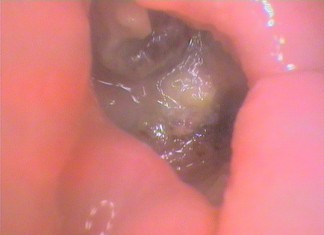Need an Appointment?
If you'd like to book an appointment with the dentist at Seymour Dental then contact us, or call us in Dulwich Hill, Sydney on (02) 9564 2397.
A dry socket is a complication that can occur after a tooth extraction. When a tooth is removed a blood clot forms, as the first step to healing. The clot covers and protects the underlying bone. Also blood vessels grow into clot to bind it to the surrounding gum.
For some reason, not always explained, the clot fails to form or bind, and it falls out, exposing the bone and delaying healing of the wound. An initial clot forms, but usually after two days, (sometimes it can occur very quickly) the clot falls apart.
Often a bad taste occurs and food gets caught in the tooth socket. The bone then becomes exposed and an aching, throbbing, dull, deep in the bone pain occurs. The pain may radiate to other teeth or parts of the head such as the ears and eyes on the same side of the face.
During normal healing, the discomfort of an extraction should lessen over time. However, if the pain increases, this may mean that healing is delayed and a dry socket has occurred.
In general, a dry socket can be a result of bacterial, chemical, mechanical, and physiological causes. Below are examples:
- Bacterial: Infection that is present in the mouth prior to a dental extraction such as periodontal (gum) disease can prevent blood clot formation. Certain oral bacteria can cause the breakdown of the clot.
- Chemical: Nicotine used by smokers causes a decrease in the blood supply in the mouth. As a result, the blood clot may fail to form resulting in a dry socket.
- Mechanical: Sucking through a straw, aggressive rinsing, spitting, or dragging on a cigarette causes dislodgement and loss of the blood clot. Blowing your nose too vigorously with upper teeth extractions may dislodge the clot.
- Physiologic: Hormones, dense jawbone, or poor blood supply are factors that prevent blood clot formation. Also certain medications alter the bone metabolism and its ability to heal. In particular the group of drugs called the bisphosphonates. The risk increases greatly when they are administered intravenously on a regular basis. Taking these drugs orally for osteoporosis is a very low risk for dry socket formation.
Who is at risk for getting a dry socket?
- Smokers
- Extraction of impacted lower third molars (wisdom teeth) can be traumatic as some surrounding gum tissue and jawbone may need to be removed or may be adversely affected during surgery. Although the extraction is necessary, the resulting trauma can increase the chances of dry socket. A dry socket occurs in 1% to 5% of routine dental extractions, but occurs in 20% to 30% for extractions of impacted third molars.
- People with periodontal (gum) disease (or periodontitis) or pericoronitis at the site of the extraction. Pericoronitis is the gum that grows partially over an impacted tooth, thereby allowing harbouring bacteria.
- Women have been found to develop a dry socket more so than men. This may be due to hormonal factors such as the use of oral contraceptives or normal hormonal changes during a woman’s cycle.
- Patients older than 30 years old with impacted third molars have an increased risk of dry socket. With age, the jawbone becomes denser and has less blood supply available. A dense jawbone increases the risk of a traumatic extraction and less blood supply increases the risk of poor blood clot formation and healing.
- A past history of getting a dry socket.
- Hormones, dense jawbone, or poor blood supply.
- Medications that alter bone metabolism and its ability to heal. (http://www.seymourdental.com.au/2011/11/04/drugs-used-for-osteoporosis/).
What is the treatment for a dry socket?
SEEK DENTAL ADVICE AND TREATMENT – Call us!
Initially, the dentist will gently irrigate to clear the socket of food debris.
Next, an analgesic medicated dressing is placed within the socket to cover the exposed bone. This usually provides immediate relief. This dressing may need to be replaced every few days during the healing process. The dressing may also contain iodine based products. If you are allergic to iodine make sure you tell all health professionals.
Additionally, medications are usually prescribed to manage the pain. Nonsteroidal anti-inflammatory drugs (such as Advil or Nurofen) or narcotics (such as Codiene formulations) are often used to relieve pain.
Sometimes antibiotics are prescribed.
Delaying contact with the dental surgeon could prolong the pain as well as the healing time.
We can’t read you minds… Seymour Dental will call to see how you are going after the procedure. Please let us know one way or the other if we leave a message. We are here to help; if we know!
Next week: The Wairoa Fund Raiser – After run report
 479 Marrickville Road
479 Marrickville Road
